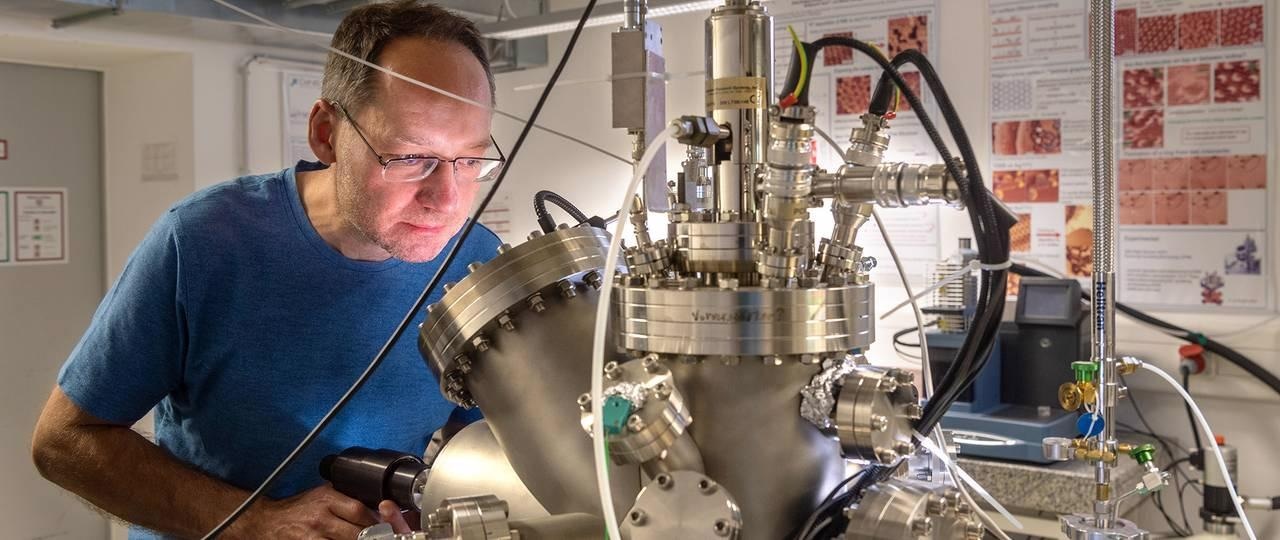Jun 10 2021
An international team of researchers, headed by members from the Technical University of Munich, the Deutsches Museum, and the Linköping University, has devised a new method to produce 2D polymers that have a thickness of just one molecule.
 Markus Lackinger transferring a sample inside the ultra-high vacuum chamber by means of a vacuum grabber. This vacuum chamber contains all facilities for preparing and analyzing samples under vacuum. Image Credit: Andreas Heddergott/TUM.
Markus Lackinger transferring a sample inside the ultra-high vacuum chamber by means of a vacuum grabber. This vacuum chamber contains all facilities for preparing and analyzing samples under vacuum. Image Credit: Andreas Heddergott/TUM.
The action of light forms the polymers on the surface. This discovery may lead to the development of new ultrathin and functional materials.
The search for new 2D materials has quickly increased with the discovery of graphene — a supermaterial material that is incredibly versatile because of its excellent properties, like strength and high conductivity.
To create ultra-thin materials, two main approaches are employed. In the first approach, a continuous layer of atoms or molecules is “peeled off” from the bulk material. An example of this material is graphene.
In the second approach, the material is constructed in a molecule-by-molecule fashion by creating bonds between the molecules in numerous ways. But in this case, the materials produced are fragile, small and contain many defects, which pose an issue. This restricts the promising areas of application.
Self-Organization and Photopolymerization Produce New 2D-Material
An international team of researchers, including members from the Technical University of Munich, the Deutsches Museum and Linköping University, among others, has now devised a new method to produce 2D polymers. The discovery makes it viable to design new ultrathin functional materials that have regular and highly defined crystalline structures.
The polymerization or manufacture of the material occurs in two steps. The investigators used a small molecule called “fantrip” — the contraction of “fluorinated anthracene triptycene”. This molecule combines two different hydrocarbons — triptycene and anthracene.
Fantrip has specific properties that cause the molecules to spontaneously organize themselves into a pattern when they are positioned onto the surface of graphite covered with an alkane. This process is termed “self-organization.’’
The subsequent step is photopolymerization, where the pattern needs to be fixed with the help of light. Illumination by a violet laser excites the electrons in the outermost electron shell of the molecules. This results in the formation of strong and durable covalent bonds between the molecules.
The outcome is a half a nanometer thick, porous 2D polymer, containing several hundred thousand molecules that are identically linked together. It can also be described as a material with almost perfect order, right down to the atomic level.
Simulations Confirm the Assigned Structures
The process can be followed on the molecular scale using scanning tunneling microscopy, since the photopolymerization is performed on a surface of solid graphite. This displays the newly formed bonds in a persistent network.
To confirm the structure assignment, the researchers, headed by Jonas Björk, have replicated the appearance of the molecular networks under the microscope at various stages of the reaction.
Jonas Björk is an assistant professor in the Materials Design Division at the Department of Physics, Chemistry and Biology at Linköping University. Leveraging the high-performance computing resources at the National Supercomputer Centre in Linköping, Björk has validated the experiments and recognize the major factors that make the technique effective.
We see that the simulations agree well with reality down to the tiniest detail, and we can also understand why our specific system gives such useful results. The next step of the research will be to see whether the method can be used to link other molecules for new two-dimensional and functional materials.
Jonas Björk, Assistant Professor, Materials Design Division, Department of Physics, Chemistry, and Biology, Linköping University
“By improving the method, we will also be able to control and tailor the type of ultrathin materials we aim to manufacture,” Björk added.
Fixing Self-Organized Molecules with Light
Creating covalent bonds between molecules requires a lot of energy. The most common way of supplying energy is to raise the temperature, but this also causes the molecules to start moving. So it won’t work with self-organized molecules, since the pattern would blur. Using light to create covalent bonds preserves the pattern and fixes it precisely as we want it.
Markus Lackinger, Research Group Leader, Deutsches Museum and Technical University of Munich
Polymerization occurs in a vacuum, which makes sure that the material is not contaminated. However, the final 2D polymer film is also stable under atmospheric conditions, which is an advantage for upcoming applications. According to Lackinger, the material will find several conceivable applications.
The most obvious application is to use the material as filter or membrane, but applications that we have no idea of at the moment in entirely different contexts may appear on the horizon, also by chance. This is why basic research is so exciting.
Markus Lackinger, Research Group Leader, Deutsches Museum and the Technical University of Munich.
Journal Reference:
Grossmann, L., et al. (2021). On-surface photopolymerization of two-dimensional polymers ordered on the mesoscale. Nature Chemistry. doi.org/10.1038/s41557-021-00709-y.